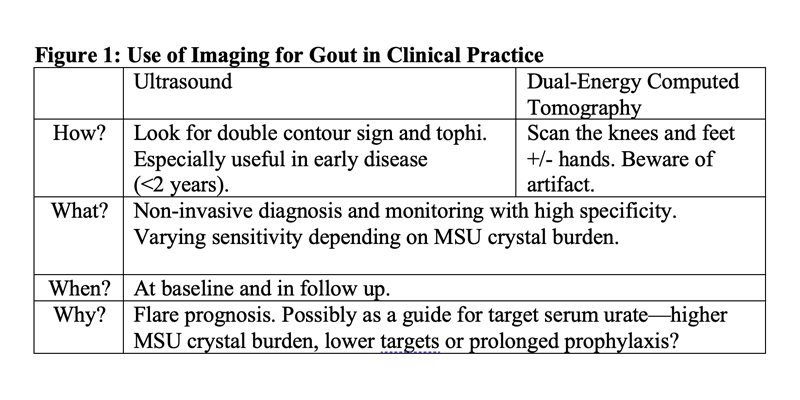DECT
When it comes to dual-energy computed tomography, Dr. Pascart noted that “diagnostic accuracy is a bit better for DECT than ultrasound, with the exception of early disease.” In early disease (i.e., diagnosis of gout within the first two years of disease onset), ultrasound is more sensitive for new deposits as appreciated by the double contour sign.5 This is because DECT is limited by resolution. Significant MSU crystal aggregates need to be present to see them.
It’s also important to make sure that radiologists aren’t counting artifact while calculating MSU crystal burden on DECT images. “Nailbeds have the same signature as MSU crystals and shouldn’t be counted. Metal implants can also cause artifact,” Dr. Pascart explained.
“I like to use DECT for prognosis and follow-up,” Dr. Pascart said, “but I do admit I’m a bit biased since it’s so cool. We know there’s a relationship between the volume of crystals measured with DECT at baseline and flare risk over the next six months.6 With ultrasound, after six months of treatment, patients with a greater than 50% decrease in tophus size had less risk of flaring after those six months of treatment.7 [Given this information], you might argue for a lower serum urate target or prolonged flare prophylaxis if tophus burden as measured by DECT remains high.”
Dual-energy computed tomography & ultrasound are both more sensitive than plain radiographs & provide noninvasive characterization of monosodium urate crystals with specificity.
Ultrasound & DECT
What about using ultrasound and DECT in combination? Dr. Pascart et al. used prospectively collected data from an outpatient rheumatology clinic to examine the diagnostic accuracy of either modality alone or in combination, by anatomical site (i.e., feet and ankles, and knees).5 “The general conclusion,” Dr. Pascart explained, “was that there was no advantage to combining the two techniques. You gained some sensitivity but lost some specificity.”
In Sum
Dr. Pascart concluded his talk with a highyield summary of the “how, what, when and why” of imaging modalities in gout (see Figure 1, below). As ultrasound and DECT become more widely available, we can all hope for better care of our gout patients in the future.
Samantha C. Shapiro, MD, is an academic rheumatologist and an affiliate faculty member of the Dell Medical School at the University of Texas at Austin. She is also a member of the ACR Insurance Subcommittee.
